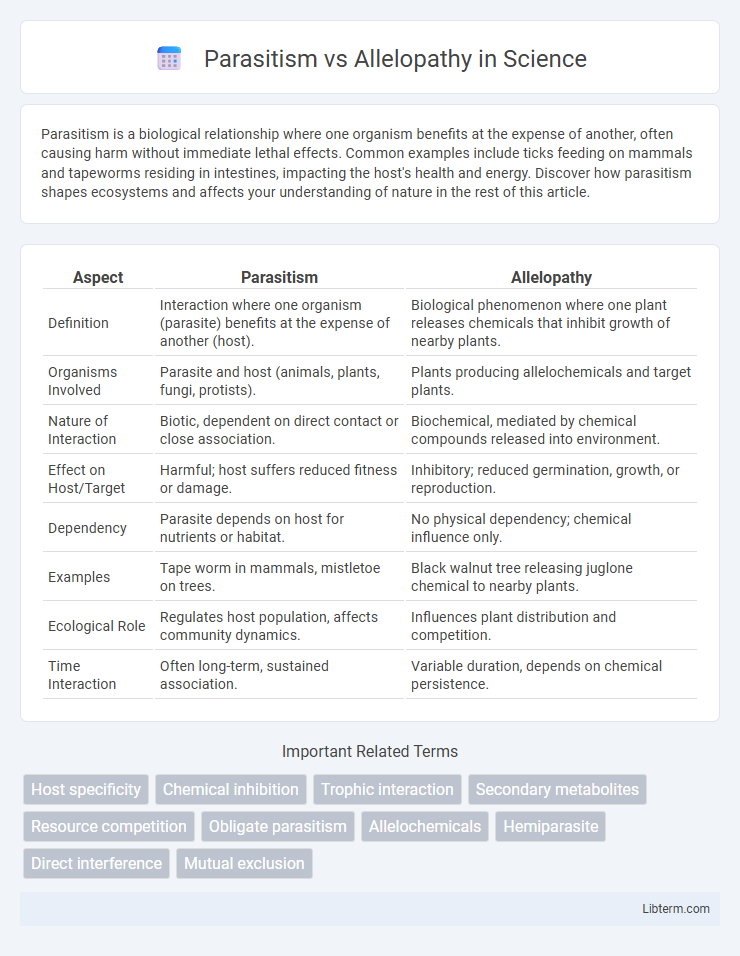Parasitism is a biological relationship where one organism benefits at the expense of another, often causing harm without immediate lethal effects. Common examples include ticks feeding on mammals and tapeworms residing in intestines, impacting the host's health and energy. Discover how parasitism shapes ecosystems and affects your understanding of nature in the rest of this article.
Table of Comparison
| Aspect | Parasitism | Allelopathy |
|---|---|---|
| Definition | Interaction where one organism (parasite) benefits at the expense of another (host). | Biological phenomenon where one plant releases chemicals that inhibit growth of nearby plants. |
| Organisms Involved | Parasite and host (animals, plants, fungi, protists). | Plants producing allelochemicals and target plants. |
| Nature of Interaction | Biotic, dependent on direct contact or close association. | Biochemical, mediated by chemical compounds released into environment. |
| Effect on Host/Target | Harmful; host suffers reduced fitness or damage. | Inhibitory; reduced germination, growth, or reproduction. |
| Dependency | Parasite depends on host for nutrients or habitat. | No physical dependency; chemical influence only. |
| Examples | Tape worm in mammals, mistletoe on trees. | Black walnut tree releasing juglone chemical to nearby plants. |
| Ecological Role | Regulates host population, affects community dynamics. | Influences plant distribution and competition. |
| Time Interaction | Often long-term, sustained association. | Variable duration, depends on chemical persistence. |
Introduction to Parasitism and Allelopathy
Parasitism involves one organism benefiting at the expense of another by extracting nutrients or resources directly from its host, often causing harm. Allelopathy refers to the biochemical inhibition of one plant species by another through the release of toxic substances into the environment. Both parasitism and allelopathy represent ecological interactions that influence species distribution, survival, and community dynamics.
Defining Parasitism in Nature
Parasitism in nature is a biological interaction where one organism, the parasite, derives nutrients and benefits at the expense of another organism, the host, often causing harm without immediate death. This relationship is characterized by specialized adaptations that allow parasites to exploit hosts for survival, reproduction, and growth. Unlike allelopathy, which involves chemical inhibition between plants, parasitism directly impacts the host's physiological functions through physical attachment or internal invasion.
Understanding Allelopathy Mechanisms
Allelopathy involves the biochemical interactions where plants release toxic or growth-inhibiting compounds into the environment, affecting neighboring plant species and microbial communities. These allelochemicals, often secreted through roots, leaves, or decomposing litter, disrupt cellular processes such as nutrient uptake, photosynthesis, and enzyme activity in competing plants. Understanding allelopathy mechanisms requires analyzing specific compounds like phenolics, terpenoids, and alkaloids, as well as their pathways and environmental factors influencing expression and potency.
Key Differences Between Parasitism and Allelopathy
Parasitism involves one organism deriving nutrients directly from another living host, often harming it, while allelopathy refers to the chemical inhibition of one plant species by another through the release of toxic substances. Key differences include the nature of interaction where parasitism is a biological dependency, whereas allelopathy is a chemical interference without physical contact. Parasitic relationships occur mainly between animals and plants or within species, whereas allelopathy is predominantly observed among plant species affecting growth, germination, and survival.
Ecological Impacts of Parasitism
Parasitism significantly alters host population dynamics by reducing host fitness, reproductive success, and survival rates, thereby influencing community structure. Parasites can regulate host species abundance, promoting biodiversity by preventing competitive exclusion and enabling coexistence of multiple species within ecosystems. The transmission of parasites often triggers cascading ecological effects, impacting nutrient cycling and energy flow through trophic interactions.
Ecological Roles of Allelopathy
Allelopathy plays a crucial ecological role by influencing plant community dynamics through the release of biochemical compounds that inhibit the growth of neighboring plants, thereby reducing competition for resources. This natural chemical warfare aids in shaping species diversity and distribution within ecosystems by suppressing invasive species and promoting the dominance of certain plants. Unlike parasitism, which directly exploits host organisms, allelopathy primarily affects ecological balance indirectly by modifying soil chemistry and plant regeneration patterns.
Examples of Parasitism Across Species
Parasitism occurs when one organism benefits at the expense of another, with examples including ticks feeding on mammals, mistletoe extracting nutrients from host trees, and parasitic wasps laying eggs inside caterpillars. Allelopathy, by contrast, involves plants releasing chemicals to inhibit the growth of competing species, such as black walnut trees secreting juglone to suppress surrounding plants. Understanding parasitic relationships across species highlights ecological interactions that influence host health and biodiversity.
Notable Cases of Allelopathy in Plants
Notable cases of allelopathy in plants include the black walnut (Juglans nigra), which releases juglone that inhibits the growth of neighboring plants such as tomatoes and maples. Eucalyptus species produce volatile oils with allelopathic properties that suppress understory vegetation, impacting biodiversity in affected ecosystems. Rye (Secale cereale) exhibits allelopathic effects by releasing phenolic acids that reduce weed seed germination and growth, widely studied for natural weed control in agriculture.
Evolutionary Significance: Parasitism vs Allelopathy
Parasitism and allelopathy represent distinct evolutionary strategies that enhance species survival through resource acquisition and competitive advantages. Parasitism has evolved complex adaptations for direct nutrient extraction from hosts, promoting coevolutionary arms races and influencing host population dynamics. Allelopathy involves chemical warfare where plants release bioactive compounds to inhibit competitors, shaping plant community structures and driving evolutionary diversification in biochemical pathways.
Applications and Implications in Agriculture and Ecology
Parasitism in agriculture often involves parasitic plants like Striga spp., which drain nutrients from crops, leading to significant yield losses and necessitating management strategies such as crop rotation and resistant varieties. Allelopathy leverages plants like black walnut or rye to naturally suppress weed growth and pests through chemical exudates, reducing the need for synthetic herbicides and promoting sustainable farming practices. Ecologically, parasitism affects biodiversity by influencing host populations and community dynamics, while allelopathy shapes plant succession and ecosystem composition through chemical interactions.
Parasitism Infographic

 libterm.com
libterm.com